The USSR enters the rocket age. Breakthrough. Creation of the R-5 rocket
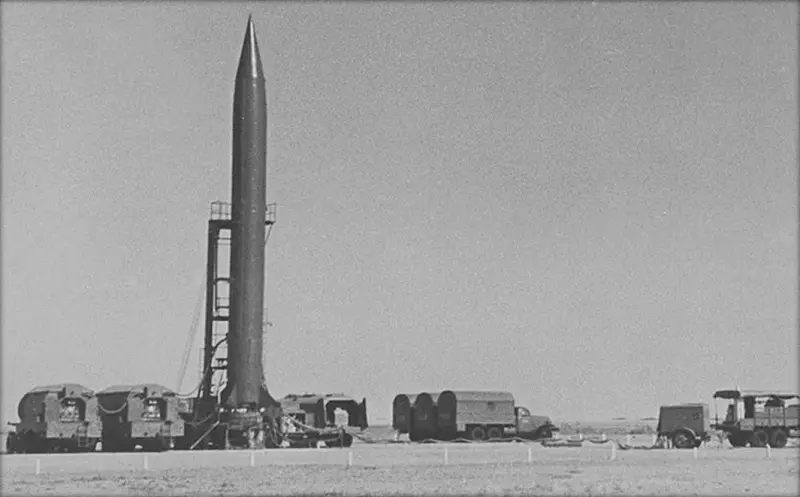
Having quickly consolidated colossal economic resources and generalized German rocket-building experience in the post-war period, by the early 1950s the Soviet Union had successfully created its own rocket industry.
During the work on the R-1 and R-2 missiles, the domestic industry made a huge qualitative leap and achieved great success, but the main breakthrough was still ahead.
The military units equipped with the R-1 and R-2 missiles, which were in service at that time, did not represent serious combat value, essentially being nothing more than experimental units for testing various aspects of the use of missiles by the troops. weapons.
Meanwhile, the times of unilateral nuclear dictatorship and the dominance of the American-British strategic aviation demanded urgent measures to create combat-ready missile forces.
The designers of the Country of Soviets had to quickly solve the problem of creating long-range ballistic missiles equipped with a nuclear warhead capable of delivering a quick retaliatory strike.
Prologue to the revolution: R-3 rocket project

Drawing of the R-3 rocket
Since 1947, on an initiative basis, Korolev and his immediate circle have been exploring the possibility of creating long-range ballistic missiles, and in the future intercontinental ones.
By 1949, all the developments on this topic were finally formed into the preliminary design of the R-3 rocket, which was successfully defended on December 7, 1949.
According to the designers' plans, the rocket was supposed to have a detachable nuclear warhead, load-bearing tanks unloaded by internal pressurization due to the evaporation of liquid gas, and using at that time revolutionary steering engines instead of traditional gas-dynamic rudders to control the rocket.
Based on the package combination of three R-3 missiles, it was planned to make the T-1 intercontinental ballistic missile in the future.
Due to the emergence of serious difficulties in the creation of oxygen-kerosene engines, the implementation of this project in its original form turned out to be impossible.
The OKB-1 engineering and design team made an attempt to return to oxygen-ethanol engines, significantly reducing the design flight range of the modification of the R-3 rocket, the R-3A rocket to 900 km, but ultimately, due to numerous technical problems, both projects were closed, and the developments on them were used to create the R-5 rocket.
Performance characteristics
Rocket length - 27,1 m
Rocket diameter – 2,8 m
Launch weight – 71,5 t
Payload weight – 3 kg
Warhead type – nuclear, non-nuclear high-explosive warhead, detachable, monoblock
Flight range – 3 km
Circular probable deviation – about 10 km
Start of development - 1949
Start of testing - not carried out
Date of adoption - not accepted
Chief designer - S.P. Korolev.
The longed-for breakthrough: the R-5 missile

Drawing of the R-5 rocket with a monoblock warhead
Having successfully summarized all their rocket-building experience and developments in the R-3 and R-3A projects, OKB-1 designers were finally able to create a combat-ready long-range ballistic missile in practice.
The R-5 rocket project was completed in October 1951. It was planned to create a missile capable of hitting enemy targets at distances of more than 1 kilometers with a conventional, and in the future, an atomic warhead with an accompanying circular probable deviation of no more than 000 kilometers.
D.I. Kozlov was appointed lead designer of the R-5 rocket. The rocket was carried out without the use of large aerodynamic stabilizers, which required the team of N. A. Pilyugin and M. S. Ryazantsev to significantly improve the on-board control systems.
For the first time, to counteract elastic vibrations newly discovered by the Don telemetry system, double redundancy was introduced into the control system, as a result of which all on-board electrical circuits were duplicated.
Extensive reworking of the command potentiometers of the gyro devices made it possible to avoid failure of the stabilization channels in the event of a break in the electrical circuits.
Duplication was introduced into the amplifier-converter, ensuring parallel operation of two circuits for each of the three stabilization channels, which guaranteed stability in the event of failure of one of the circuits.
The number of onboard steering gears was increased from four to six, and in each of them the relay windings began to be duplicated, in addition, each of them now had its own path to the amplifier-converter. Now a single failure of any steering gear could not lead to loss of controllability.

Technical position of the R-5 missile
The R-5 rocket had load-bearing fuel and oxidizer tanks, with internal frames and funnel-dampers installed for the first time, significantly reducing the volume of unused fuel residues.
Due to the introduction of pump supply of hydrogen peroxide, it was possible to replace the heavy steel fuel tank with a working pressure of 50 atmospheres with an aluminum one with a pressure of 3,5 atmospheres, while significantly reducing the mass of the rocket.
The rocket engine was an uprated single-chamber RD-103 with the function of regulating thrust in flight, designed by V. P. Glushko.
Due to a significant increase in pressure in the combustion chamber, in order to increase thrust, it was necessary to significantly increase the strength of engine components and assemblies.
As a layout scheme for the warhead, options were considered for installing both a monoblock TNT warhead and a combined one, with the placement, in addition to the main warhead, of 2 to 4 additional suspended warheads.

Drawing of the R-5 missile with four additional warheads
Due to the absence in the early 1950s of compact nuclear charges for the R-5 missile and the obvious ineffectiveness of TNT, an attempt was made to significantly increase its lethality by installing on board a chemical warhead filled with a radioactive solution, for which purpose, in the image of the Geranium warheads and “Generator” for the R-2 missile, for the R-5 the “Generator-5” warhead was created.
This warhead was a cassette consisting of small vessels with radioactive liquid placed around its circumference in its volume.
According to the authors, the high-altitude detonation of this warhead was supposed to lead to long-term radioactive contamination of the area, making it unsuitable for further use by the enemy.
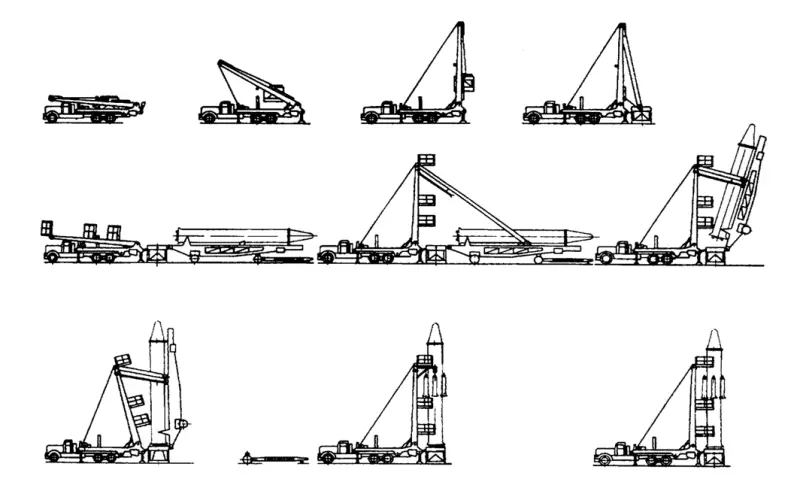
Illustrated process of installing the R-5M rocket on the launch pad
The first fire and bench tests of the R-5 rocket began in 1953 on the territory of the Zagorsk Research Institute-2. Flight tests were supposed to be carried out in three stages.
In the first stage, carried out in March–May 1953, eight missiles were launched, of which six were able to successfully reach the target.
At the second stage, carried out in October - December of the same year, seven launches were carried out at the full rocket distance of 1 km, of which only one was unsuccessful.
Due to the need to refine the design, the third stage of testing moved to August 1954 and was carried out until February 1955. A total of 19 launches were carried out, 5 for sighting, 10 for test launches and 4 launches for testing the radio range correction system.
The last third stage of testing was mainly aimed at testing the reliability of the R-5 systems for its further trouble-free use as a carrier of an atomic warhead.
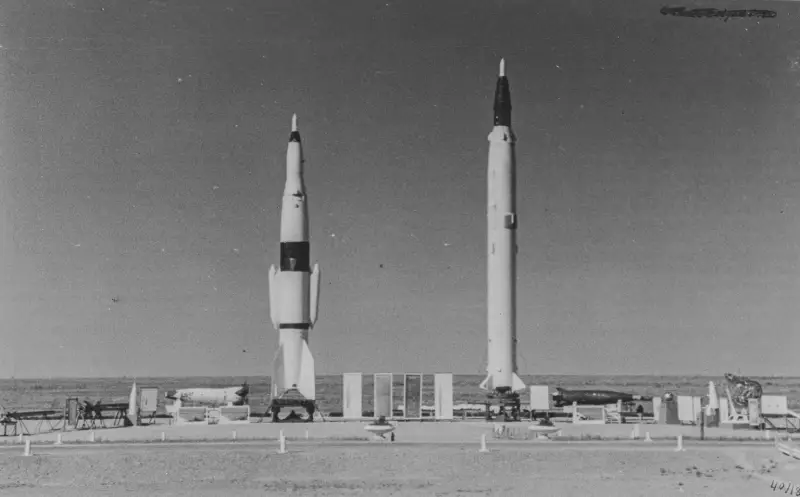
Geophysical rockets R-2A and R-5A at the exhibition of the Kapustin Yar test site
Over the entire period, 5 auxiliary modifications of the R-5 rocket were created, in addition to the nuclear R-5M, necessary for testing certain tasks within the framework of the Soviet missile program: geophysical R-5A, R-5B and R-5B, R-5R for testing in flight conditions, radio systems for measuring the speed of the rocket, as well as the R-5RD, which was used to test the autonomous guidance system and the adjustment system for the second stage of the R-7 rocket.
Performance characteristics:
Rocket length - 20,75 m
Rocket diameter – 1,65 m
Launch weight – 29,1 t
Payload weight – 1 kg
Warhead type – non-nuclear high-explosive warhead, chemical warhead, based on a radioactive mixture, detachable, monoblock
Flight range – 1 km (with one warhead), 200–810 km (with two warheads), 820–560 km (with three warheads)
Circular probable deviation – 5 km
Start of development - 1949
Start of testing - 1953
Date of adoption: 1956
Chief designer - S.P. Korolev.
At the dawn of the nuclear missile era: the R-5M missile

Drawing of the R-5M missile with a monoblock nuclear warhead
At the very beginning of 1953, a meeting of the Presidium of the Central Committee was held, at which the Deputy Chairman of the Council of Ministers of the USSR and concurrently the new head of the atomic department, V. A. Malyshev, made a report on the latest achievements in the field of development of atomic weapons.
Two resolutions were adopted at this meeting. The first resolution required the development and testing of a small thermonuclear warhead, the second - the development of intercontinental delivery vehicles for it, in the form of ultra-long-range cruise and ballistic missiles.
In the absence of a full-fledged intercontinental ballistic missile, OKB-1 proposed creating a modification of the R-5 missile capable of carrying a nuclear warhead - the R-5M.
Later, the creation of the R-5M was formalized by a separate decree dated April 10, 1954.
Prototypes of the R-5M missile have been produced at Plant No. 88 since 1953, but mass production was launched only in 1956 at Dnepropetrovsk Machine-Building Plant No. 586.
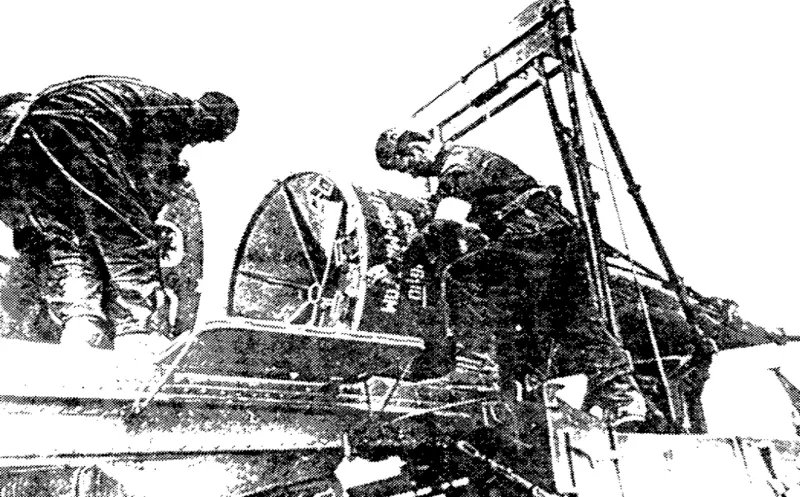
Installation of the warhead on the R-5M rocket
Designing the warhead for placement on the R-5 rocket, a nuclear charge developed under the leadership of S. G. Kocharyants, required solving many problems, both technical and production.
Due to the total secrecy of the atomic department, in order to organize joint work with designers from Arzamas-16 on the R-5M warhead, it was necessary to create a separate interdepartmental special regime group, the so-called “Sadovoy group”, which had its own closed classified records management and a separate production base.
The use of a nuclear warhead required a radical increase in the reliability of the rocket, as a result of which triple quality control was introduced in production, modeled on the nuclear industry.
All instructions for pre-launch preparation were revised, and the following were now responsible for control: the main executor from the military unit (soldier or officer), the controlling officer from the range management and a representative of the defense industry.
In addition, in order to prevent the missile from falling on allied targets, for the first time, an emergency missile detonation system was installed on the missile.
It was assumed that if, due to some failures, the missile deviated significantly away from the target or, instead of hitting enemy territory, threatened to hit its own, it would self-destruct in flight.
Protection against a false command for self-detonation was provided by a multi-stage blocking, which was removed as preparations for launch took place, finally bringing the APR system into readiness mode only at the 40th second of flight.
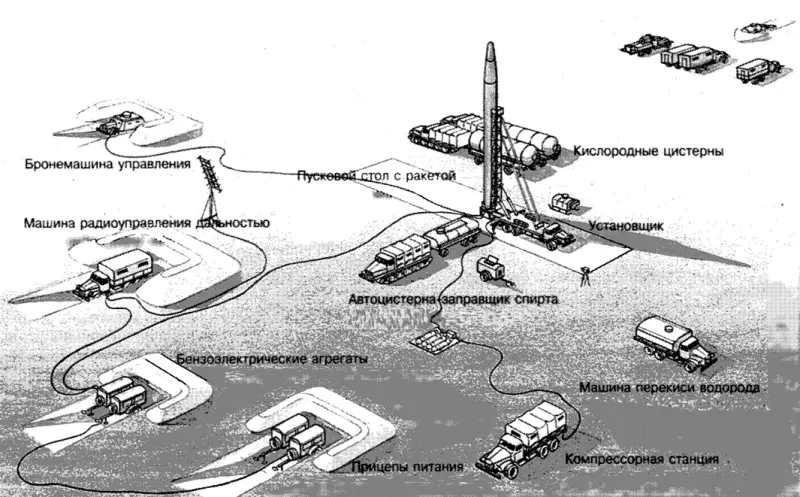
Diagram of the launch position of the R-5M rocket
In January 1955, tests of the R-5M rocket began at the Kapustin Yar test site, which continued until July. During their implementation, 14 launches were carried out, of which 13 were successful.
Based on the test results, due to the detected flutter of the air rudders, some modification of their design was carried out, which involved correcting their aerodynamic shape and significantly increasing the rigidity of the steering drive.
From August to November 1955, as part of the final sighting tests, 10 launches were carried out at a range of 1–080 km, five of which included launches with experimental weight and size mock-ups of nuclear charges.
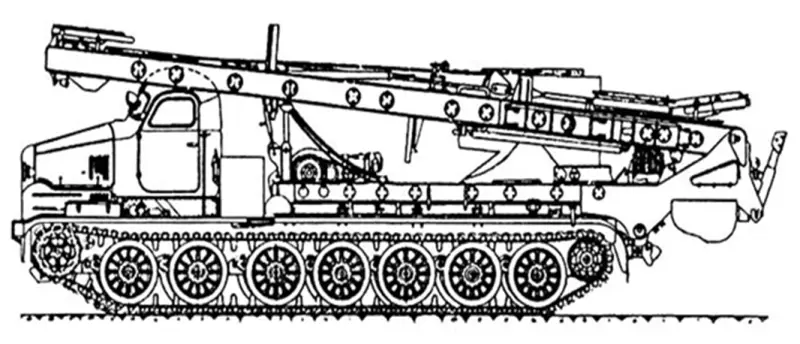
Installer 8U220 for the R-5M missile
Performance characteristics
Rocket length - 20,75 m
Rocket diameter – 1,65 m
Launch weight – 29,1 t
Payload weight – 1–350 kg
Warhead type – nuclear 0,08 Mt, 0,3 Mt and 1,0 Mt, detachable, monoblock
Flight range – 1 km
Circular probable deviation – 5 km
Start of development - 1954
Start of testing - 1955
Date of adoption: 1956
Chief designer - S.P. Korolev.
Atomization of missile weapons
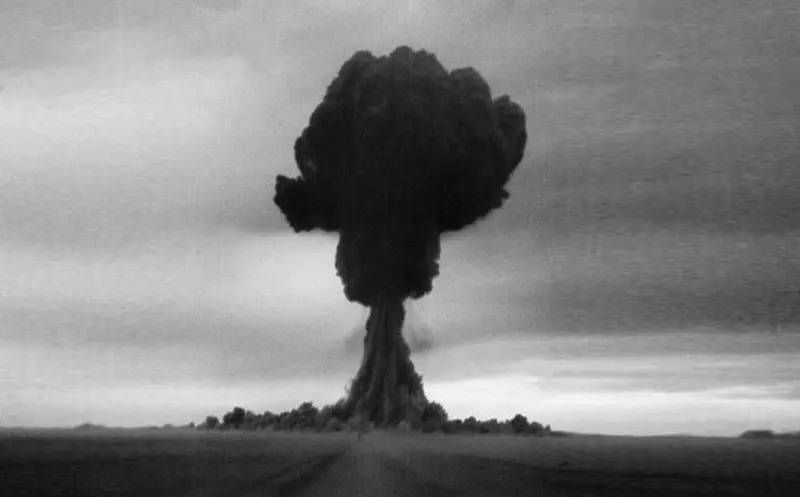
Archival photograph of an atomic explosion similar in kilotonnage to that of the exploded warhead of the R-5M rocket during testing in 1956
On February 2, 1956, the first world stories testing a long-range ballistic missile equipped with a nuclear warhead.
As part of Operation Baikal, carried out at the insistence of Marshal of the Soviet Union G.K. Zhukov, at 10:30 Moscow time, an R-5M missile equipped with an atomic warhead took off from the 4N launch site at the Kapustin Yar training ground and rushed to the designated strike area near the city of Aralsk .
Having covered a distance of more than a thousand kilometers, 10 minutes and 30 seconds from the moment of launch, the warhead of the R-5M missile reached the ground, and an 80-kiloton nuclear explosion followed, marking the transformation of missiles into weapons of mass destruction.
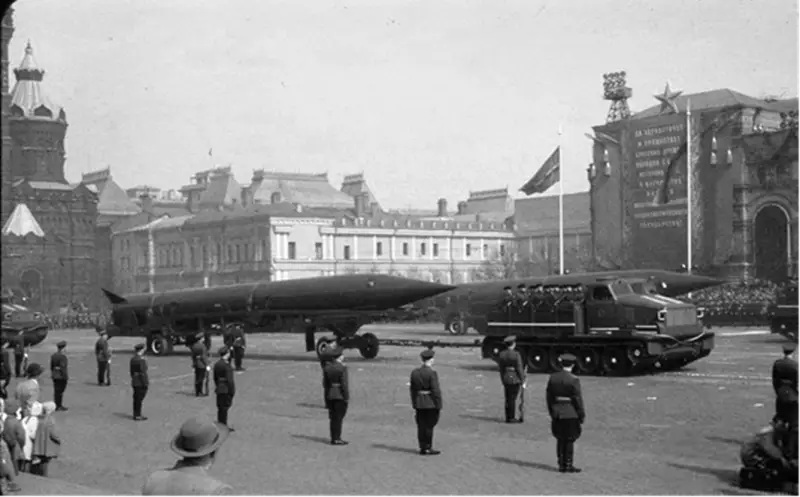
R-5M missiles at the parade on Red Square
Since 1956, the formation of the first combat formations equipped with R-5M missiles with nuclear charges began at the Kapustin Yar training ground.
In addition to the six brigades that already existed at that time, two additional three-divisional missile brigades were formed, each of which included two launchers, thus, each brigade was armed with six R-5M missile launchers.
In 1956, military units received the first nuclear warheads for R-5M missiles, and in the following year, during exercises, under military conditions, their experimental assembly was carried out for the first time.
On November 23, 1957, the 12th Main Directorate of the USSR Ministry of Defense was formed for the development, testing and operation of atomic weapons; later, two years later, it would be included in the newly formed strategic missile forces.
R-5M missiles with nuclear warheads were in service with eight RVGK engineering brigades: the 77th and 30th, stationed in the Carpathian Military District; 72nd – stationed in the Novgorod region; 73rd - stationed in the Stalingrad region; The 90th was stationed in the Kiev Military District, the 97th was stationed in the Kaliningrad region, the 29th was stationed in the Khabarovsk region, and the 85th was left at the Kapustin Yar training ground.
By the end of 1957, the Soviet R-5M group consisted of 48 launchers.
To service nuclear warheads of missiles, so-called repair and technical bases were formed in 1959.
At first, due to the lack of special facilities, the storage of missile warheads and their preparation for combat use by troops was carried out in temporarily adapted places: in special railway cars, cars and even tents, but with the commissioning of stationary structures, nuclear warheads began to be stored in bunkers on the territory of the repair center. -technical bases.
German business trip

The radius of destruction of the R-5M missile when firing at the maximum distance (1 km) from the vicinity of Furstenberg
By the end of the 1950s, the Soviet leadership finally received combat-ready missile weapons, so already in 1958, in order to somehow contain the American-British nuclear dictatorship, Marshal R. Ya. Malinovsky, in agreement with the top leadership of the USSR, gave a secret order to redeploy to the territory of the German Democratic Republic of four R-5M missiles as part of two missile divisions of the 72nd engineering brigade of the RVGK, so that from the territory of the GDR they would be able to hit the entire north-east of France and the south-east of Great Britain.
Loading onto railway platforms previously based in the Novgorod region, the R-5M divisions headed west.
Upon arrival, the first missile division was located in a forest near the city of Fürstenberg, the second, together with its headquarters, was located near the Soviet military airfield Templin.
Thanks to exceptional security measures, including movement, maintenance and training of pre-launch activities only at night, during the two-year stay of the R-5M missiles in the GDR, NATO intelligence was never able to reveal the fact of their presence.
At the end of 1959, R-5M missiles were withdrawn from Germany due to the emergence of long-range R-12 missiles in the USSR, which ensured the defeat of almost all of Europe from the western regions of the USSR.
The R-5 missile became the first domestic ballistic missile with a nuclear charge to carry out combat duty abroad.
The role of R-5 and R-5M missiles in the history of domestic rocketry

Rocket R-5M on Red Square during the parade in Moscow
Despite the fact that the R-5M missile inherited a lot of shortcomings from the previous R-1 and R-2 missiles, such as, for example, an open launch pad that was in no way protected from airstrikes, due to which its appearance could not provide an effective nuclear deterrent to the United States , it was she who was destined to become the breakthrough that would later allow the Soviet Union to complete a scientific and technological revolution.
The creation and mass deployment of advanced medium-range ballistic missiles R-12 and R-14, as well as the world's first intercontinental ballistic missile R-7 by the end of the 1960s will finally break the Anglo-American atomic dictatorship.
Sources:
1. A. V. Karpenko, A. D. Popov, A. F. Utkin “Domestic strategic missile systems.”
2. Publishing house "Military Parade" "Strategic ground-based missile systems."
3. B. E. Chertok “Rockets and People”, volume 2 “Podlipki - Kapustin Yar - Tyuratam”.
4. I. G. Dorgovoz “Missile Forces of the USSR”.
Information